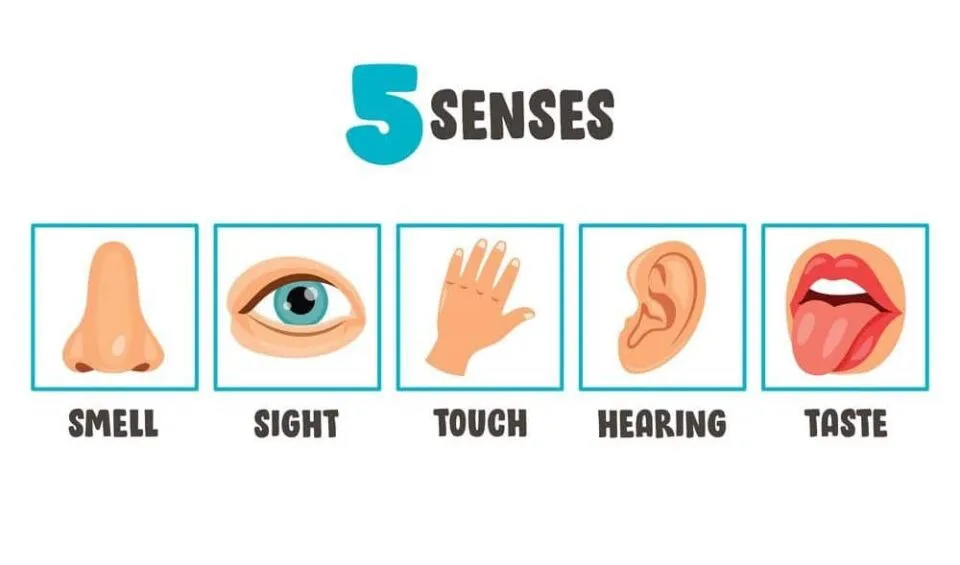What Are Senses?
Contents
Senses give us the ability to observe and understand that what is going on around us.
It help us to see something, feel something, listen, to smell something, and humans have 5 common senses which include:
- Sight
- Smell
- Hearing
- Touch
- Taste
The senses used by animal beings are more numerous in variety and number, and apart from just these 5 senses, we have other senses.

Senses Organs
Humans have various sensory organs and some common which include:
- Eyes (give a sense of vision)
- Nose (Give a sense of smell)
- Ears (Give a sense of hearing)
- Mouth (Give a sense of taste)
- Skin (Give a sense of touch)
NOTE: Animals also experience sensations, different from humans, some animals can detect air moisture, magnetic field, etc.
Human senses are not as strong as mammals, and e.g: Dog, and Cat have a great sense of smell, Owl has great eyesight.
How Do Senses Work?
When receptors have stimulated, they send signals to the brain.
When the brain receives any signals, then it encodes the signal, basically which tells us the smell of perfume, the sound of the car, etc.
NOTE: Our 5 senses have their own special sensor, each sensor collects information about what is going around us, and sends it to the brain.
Parietal lobe plays a major role in the senses, which processes sensory information, and harm in the partial lobe may lead to severe issue.
Common Senses
Humans have 5 common senses which are very essential to understanding, observe something. here are 5 common senses:
Sight
As we know eye helps us see something, which is protected by bone and fat.
The human eye can distinguish about 10 million colors but using a laptop, mobile has a lot of negative effects on your eyesight.
The human eye has a rod, and code cells (responsible for color vision and eye color sensitivity, as well as Rods (help us to see in low-light vision)
Then the optical nerve carries the signal from the eye to the brain, which converts them into a visual image.
Smell
It is believed that our sense of smell is our oldest sense, and humans have 400 smelling receptors which help us to smell different things. but how?
E.g – A flower has hundreds of very tiny molecules, which are present in them, and when we smell its molecules, they settle on the roof of our nostrils, which helps us to smell.
Early believed that humans only have 10,000 different smells, but research suggests that humans have 1 trillion different odors.
Hearing
It reach the ears through sound waves in the air, but How does this hearing sense work?
The ability to correctly decode sound is possible due to our Auditory system which has 3 main parts such as:
Outer ear: When sound waves reach our outer ear, they travel through our Pinna (which acts as a funnel) and then the ear canal to the middle ear.
Middle ear: Through the ear canal, the sound hits the Eardrum which makes it vibrate.
Inner ear: Then through the Ossicle, sound travels into the Cochlea (a small circular tube, filled with liquid) which creates waves in the Cochlear fluid.
The cochlear is consists of many hairs and when the fluid in the cochlea moves, this tiny hair also moves.
Which creates nerve signals that get sent through the auditory nerve into the brain, then the brain process this signal as sound.
Humans can detect sounds in a frequency range from around 20 Hz to 20 kHz.
Touch
Our touch sense is controlled by a large network of nerves and touch receptors in the skin are known as the somatosensory system.
The somatosensory system is responsible for all sensations like hot, smooth, cold, rough, itch, pain, vibrations, and more
Then, this signal goes to the brain through nerves, which process this signal as touch.
Taste
Our tongue is responsible for taste, which has 5 basic taste buds, that find out the taste include – Sweet, Sour, Umani, Salty, and Bitter.
The taste buds contain taste receptors also called taste cells.
Taste buds have a very sensitive small microscopic cellular membrane called Microvilli.
These microscopic send signals to the brain, then the brain processes the signal and tells what taste is it.
What’s Human 6th Sense?
As we know that humans have 5 senses which we know, but there is something called proprioception our 6th sense.
This basically helps us to navigate even in the dark or gives us the ability to sense exactly where our body is.
It is present in your entire body, especially in joints, muscle, skin, and mechanosensory neurons.
Vestibular sense

This sense of balance contributes to the perception of balance.
It is a sensory system that is responsible for providing our brain with information about balance, head position, and awareness of movement.
NOTE: This essential structure related to the vestibular faculties is found in the internal ear.
The vestibular sense likewise leads information from the utricle and the saccule.
The utricle and saccule are two otolith organs in the vertebrate inner ear that maintains the stability of the head rotation.
Do We Have More Senses?
Yes, we have more senses than 5.
As we know we have 5 major senses, but scientists suggest that we have more senses which may have abilities we never suspected.
Pressure: This is a quite different sense from the sense of touch.
Thermoception: It is the ability to sense cold, and hot, and there are different thermoreceptors in our brain.
Equilibrioception: It is also known as the sense of balance, which allows you to keep your balance, and sense of your body movement.
Hunger: I think this sense all know, which allows you to know that you are hungry and you need to eat something.
Tension sensors: It is found in our muscles, that allow the brain to monitor muscle tension, which tells us we’re in pain now, we should put it to now.
Nociception: This sense gives us the ability to feel pain, and this is more than just touching because of its different sensory systems.
Chemoreceptors: It is located in the respiratory center at the base of your brain, which monitors carbon dioxide and oxygen levels.
Magnetoception: This sense allows to detection of a magnetic field to perceive direction, location.
Thirst: It is well known to all that this sense allows us to drink water when we are thirsty, which also keeps us hydrated.
Down Line
The human eye can distinguish about 10 million colors but using a laptop, mobile has a lot of negative effects on your eyesight.
Senses give us the ability to observe and understand that what is going on around us.
Proprioception is our 6th sense which gives the ability to sense the movement, location, and action of your body.




I was recommended this blog by way of my cousin. I’m no longer sure whether this put up is written through him as no one else recognize such particular approximately my difficulty. You are amazing! Thank you!